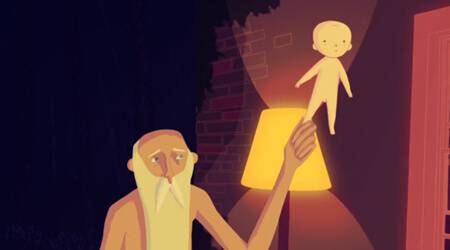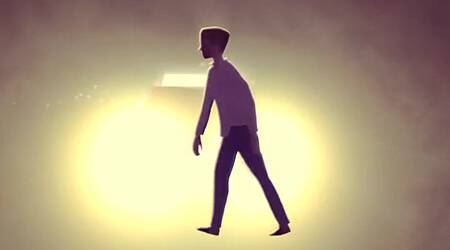An Interview with ‘Coda’ director Alan Holly
Alan Holly‘s Coda has been an animated short film highlight for many festivalgoers over the last year and a half and is finally available to watch online in full as of this week. Shortlisted for the 2015 Academy Awards and nominated for an Annie Award, the film has racked up a stunning eighteen awards and counting during its international festival run which has included OIAF, Encounters, LIAF, Aesthetica Short Film Festival and Anima Mundi. A veteran of the Irish animation industry, Alan worked as part of the talented creative team And Maps and Plans to create a masterful and emotive traditionally-animated piece both chilling and heartwarming. To time with its online release we took the opportunity to catch up with the director to learn more about how this intriguing film came to be.
Could you tell us a little about your background prior to Coda – was directing and writing for animation always something that was on the cards for you?
I have been working in the Irish animation industry for just about ten years now, in different jobs, animator, writer, background artist, editor and then directing my own projects when possible. I think that growing up I always had a vague notion of wanting to make films. I would always visualise the things I read as animation but I don’t really remember being aware of the idea that writing and directing were ways in which you might achieve that. I never wrote stories growing up, I entered into animation because I liked to drawn and loved art. It was really only in college, while studying animation, when I had to first make a short film, that I realised that writing and directing were what I really wanted to do.
When did your involvement with And Maps and Plans begin, and what type of other work has the group worked on?
I’ve been involved with and maps and plans since its beginning, in 2010. We started out with a music video for singer Jennifer Evans and following that Coda is the first film project we have completed. Prior to working together as and maps and plans we had all be working different jobs over the years, freelance and in different studios, but we had all worked together at various points particularly on different short film projects.
Would you categorise And Maps And Plans as a studio or is it more set up as a collective for particular types of projects?
That is something we are still figuring out. We do call it a studio but I think in actual fact it functions more as a collective for particular projects and that is really what it was set up for. We have a studio space in Dublin that we work from, both on our own separate projects and then as and maps and plans when there is something we can work together on. I think we would all like to see it grow into something more of a full time functioning studio but only if it can retain the same ethos and focus on personal and collaborative artistic projects. Its certainly not a business, that’s for sure.
I’d love to know where Coda itself comes from. What were the first seeds of the idea and was it destined to be an animated short from the outset?
It was always going to be an animated project in some form, absolutely. It developed from a few separate ideas, specifically the image of the baby born into the void and that of the lost soul in the city. I had these two images with me for a long time and would always return to them and over time I gathered different other ideas to them and the story grew out of them. I also really wanted to make something that was set quiet specifically in Dublin, now and with people my own age in mind. The idea is also influenced by a lot of music, I will listen to a lot of music when I am working and particularly when developing ideas. And with Coda, as in the title, music is a major part of the film.
In practical terms, what were the circumstances behind the film’s production? Was it a passion project and, if so, what sort of resources were available to you to help it along?
It was definitely a passion project but we did receive funding to make it through the Irish Film Board’s ‘Frameworks’ scheme which funds a number of animated shorts each year in collaboration with The Arts Council and RTÉ and without this I don’t know how we would have made it. Even with this funding everyone involved put in a lot.. a lot more work than there was funding for. It was a pretty tough production and went on for far longer than initially planned, but we really wanted it to be right and so we kept at it until we felt that it was.
Do you feel that the animation scene is strong where you’re based, and is it generally supported amongst the arts?
I think it is quite strong, the industry is definitely quite healthy at present with quite a bit going on. There are a lot small companies and a few bigger ones producing a relatively varied range of animation and the quality seems to be getting better and better. There are also three colleges now in Dublin with dedicated animation courses so there are a lot of students graduating each year into the industry. We have good support here as far as Arts funding is concerned and I think that, between that and a fairly vibrant commercial industry there is a good balance for continued development and improvement. We have unfortunately seen quite substantial cuts to funding over the past few years, which may well have a knock on effect in the coming years, but we are still lucky enough to have funding schemes for both short and feature animation as well as other funding opportunities for television and tax incentives for larger productions.
What was the visual development process for Coda? Were certain motifs (such as the ethereal use of colour and some characters having no facial features) symbolic or simply stylistic choices for the film’s atmosphere?
The film grew out a lot of very rough sketches. I tend to work pretty rough during the ideas stage, just getting the ideas down as quick as possible in my notebook before I miss them. But I had a pretty good idea of how I wanted different aspects of the film to look. It was very important to me with this film that the story be told in a very visual way, the previous short films I had made had been quite sparse so I wanted this film to be richer in mood as well as visual content. The story dictated it too. Colour is definitely very important for me for mood and for trying to communicate certain feelings. Colour effects us in a very subtle way and then it is also just a great pleasure, something to be enjoyed. The decision to leave out certain detail was in part about placing our focus on the main character but also about leaving those background characters as blank slates, particularly in the second half when they are the memories of events and people. In the first half it is also just to do with the way things feel sometimes and a lot of the time you just don’t fully take in who is around you and this is one of those situations.
In terms of the animation itself, were there any sequences that proved more challenging than others in terms of getting your intentions across?
I’m sure there were. I may have blocked the memories out. It all took a long time.
 Is there a particular origin – either visually or culturally (or both) – behind the depiction of death as a character in the film? It seems to have more uniqueness to it than most personifications in film and literature (being identifiably female for example).
Is there a particular origin – either visually or culturally (or both) – behind the depiction of death as a character in the film? It seems to have more uniqueness to it than most personifications in film and literature (being identifiably female for example).
I really wanted there to be a warmth to Death’s character in the film and I think Orla Fitzgerald’s voice really gave it this. I didn’t want Death to be portrayed as a character or idea to fear. Though she does still retain this power in part, I thinking the overall impression is not that. I also really didn’t want any male death/father/god feeling to the film, I am much happier with a potential death/mother/goddess association, though this is not the intention either. It is very much a non religious film as far as I am concerned, despite there being a soul as a main character for a large part of the film. I do not hold religious beliefs, or I hold anti religious beliefs.
Similarly, does the transitional limbo the protagonist finds himself take inspiration from anything or is it more of a personal vision of how we might reflect on our lives spent?
I suppose it comes in part from the idea of someones life flashing before their eyes or the last moments of brain activity but I do not like to think of it as that. It is pushing that a little further, like you say as a way to reflect. I do just like this idea of the void, its kind of a thinking space.
There’s a true sense of creative interplay at work within the film that fully rounds it out and gives it its atmosphere. Could you discuss your various working relationships with/strengths of the fellow artists who worked on the film, in particular the composer Shane who did such a fantastic job with the music?
There was a core team of five of us. With myself, Rory Byrne and Ronan McMeel doing the visuals, Shane Holly doing the music and Ciaran Deeney producing. It was definitely a group effort and wouldn’t have been the same film if any one of us hadn’t been a part of it.
Rory, Ronan and I have all known each other since college and worked together over quite a few years, so I think we know each others strengths and tastes quite well. Rory is an excellent animator, artist and filmmaker in his own right. Ronan is a very talented designer in general with a great attention to detail, as well as also being a talented photographer and visual effects artist. There was definitely a lot of crossover of skills. We storyboarded the film, all three of us, really developing a lot on the script, particularly regarding the ending which was still somewhat undeveloped as it was in the script. Myself and Rory then did quite a major rewrite of the dialogue in the first half of the film and really paired it back to what was most important. At the same time Ronan was developing the final background style based on what we had done in the boards. I worked up the final designs for the main characters, with the exception of the fox which Rory did, as well with the bulk of the background characters. From there we put our heads down and got to work on the production.
I’ve worked with Shane for music on all of my previous films and they are always envisioned with his music in them, so he is always involved from as early on as possible. Shane plays guitar, drums and piano as well as being an excellent composer and arranger. We will have a lot of back and forth throughout the production with me sending him updated versions of the animatic and him sending me updated versions of the music. To begin I build a temp track to the first rough cut of the animatic from various music to give Shane an idea what I have in mind, mood and tempo wise in various parts of the film. From this Shane will make a first pass composition, using guitar, piano and keyboard synths and I will then re-cut the animatic to this and we will then work together throughout the production to time the animation to the music and the music the animation. It is very important for the both of us the the visuals and music really work together. The final music for Coda was recorded after the final animation was finished.
It was great to work with Ciaran for the first time on the film. He was an amazing support throughout, remaining positive about the film even when things weren’t going exactly to plan. Ciaran is director as well as producer himself, making live action and documentary with his own company El Zorrero Films so he has a lot of experience in independent production. He made sure that the quality of the final film and the idea remained the priority.
Can you tell us anything about the upcoming film At The Surface and when people can expect to see it do the rounds?
At the Surface is I think quite different from Coda. It is a simpler story, about first loves and friendships and the tensions that can go with that territory, so its that but with a fantastical element to it and the hope is that it will be quite atmospheric. Music is a big part of it too, like Coda and Shane has again written some beautiful music for it. We don’t have a release date at present, it won’t be ready until next year anyway.
If able to be discussed, what else are you working on at the moment/in the future?
I am putting the finishing touches on a workshop film I made with 15 participants at the Milano Film Festival. It is a one minute short made in collaboration with the Milanese musician AntiteQ and it will hopefully be ready soon. It is long overdue. So I’m working on that and At the Surface at present. Rory Byrne is developing a new short of his own which we are really hoping to be able to get into production too. And hopefully we will be able to get a few other small and diverse projects off the ground in the next few years. Beyond that the plan remains to move towards development of feature or longer form projects. That’s really what I want to do. Oh time, Oh money.
From today you can watch Coda in full and learn more at andcodafilm.com and andmapsandplans.com
To catch the film on the big screen be sure to check out the latest This is Not a Cartoon screening at Manchester’s HOME on June 28th, 4pm.
For more on the work of Alan Holly you can visit qlqn.ie and follow him on Twitter @qlqn




